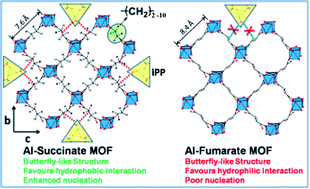Enhanced nucleation of polypropylene by metal–organic frameworks (MOFs) based on aluminium dicarboxylates: influence of structural features†
Abstract
Metal–organic frameworks (MOFs) based on aluminium dicarboxylates provide a new platform for the enhanced nucleation of isotactic polypropylene (iPP). For instance, aluminium dicarboxylates exhibit a unique butterfly-like structure similar to that of carboxylate-alumoxanes and correlates well with the nucleation characteristics of iPP. A subtle change in the structure of the ligand backbone (fumarate/succinate) does not alter the framework structure despite changing the hydrophilic/hydrophobic character and its subsequent nucleation characteristics. This suggests that the nucleating agent should facilitate favourable interaction with hydrophobic iPP for efficient nucleation. Further, a systematic variation of the alkyl chain length in the Al-dicarboxylate does not change the nucleation efficiency considerably, even though it increases the distance between the octahedral alumina chains in the metal–organic framework, suggesting that the butterfly-like structure present in the framework is a key aspect for nucleation. Finally, the significance of the orientational conformation of the dicarboxylate around the metal centre for the nucleation is confirmed by the poor nucleation efficiency of chromium and zirconium suberate MOFs where the orientation of suberate would be different from that of aluminium suberate due to the difference in the ligation of the carboxylate group. The present work thus provides valuable pathways for developing new nucleating agents based on MOFs with appropriate selection and orientation of the organic linkers around the metal centre.


 Please wait while we load your content...
Please wait while we load your content...